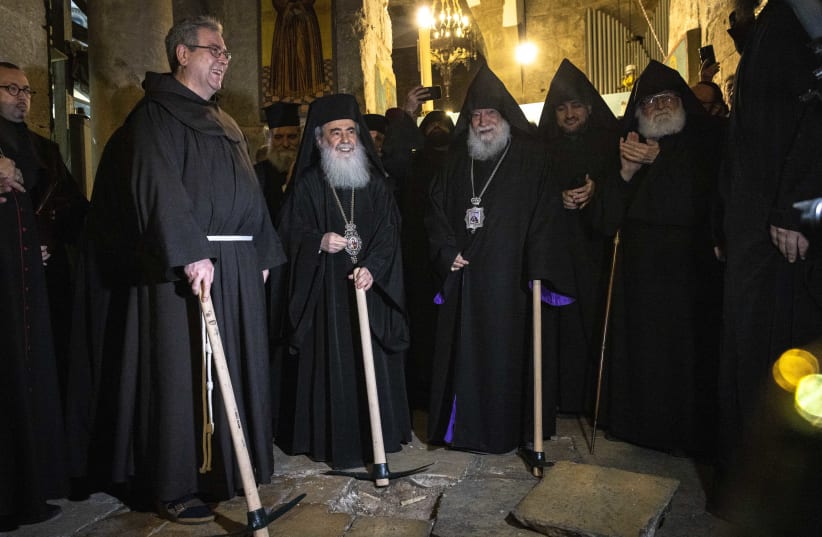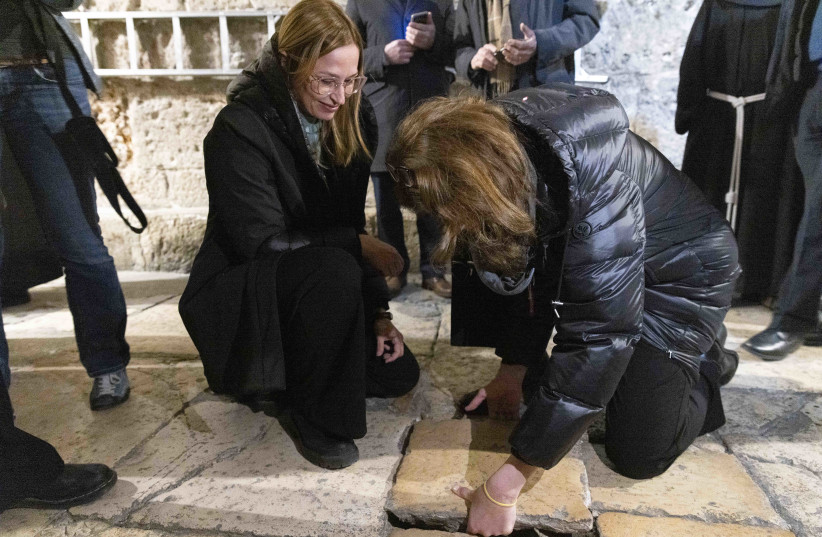An archaeological study of the floor under the Church of the Holy Sepulchre will be possible for the first time, after a two-year undertaking to repair and restore its pavement stones got underway in an inaugural ceremony on Monday.
This is the second phase of restoration work in the church following the restoration of the Edicule in 2016-2017, revered by Christians as the tomb of Jesus, which was directed by the Greek Orthodox Patriarchate and conducted by an interdisciplinary team from the National Technical University of Athens.
The current work is being conducted under the direction of the Custody of the Holy Land in cooperation with the Greek Orthodox Patriarchate and the Armenian Patriarchate, the three historical guardians of the Church, according to the 1852 Status Quo agreement that solidified the territorial division among the Christian communities in the church and other holy Christian sites.
“We don’t know what is beneath the floor,” said Prof. Giorgio Piras, director of the Department of Ancient Sciences at the Sapienza University of Rome, which will be responsible for the archaeological excavations of the entire floor area during the restoration of the pavement. “It has never been systematically excavated, so we don’t know what we shall find. But it should be at least some remains of [Roman Emperor] Constantine’s church.
“We hope to understand the structure of this very holy place. Maybe there will be some remains from Hadrian’s Temple.”
The pavement stones date from various periods ranging from the medieval period to last century, he said.
Father Eugenio Alliata, director of the Franciscan Terra Sancta Museum’s archaeological section, said most of the pavement stones appear to be from the early 19th century, other parts may be from the Crusader period, and a smaller section – especially in areas underneath the Church, such as the area called the Prison of Christ – may even be from the period of Constantine. Analysis of the stones will need to be done to confirm their age, he said.
All work will be conducted with the cooperation and coordination of the Christian communities, Piras said.
Most of the remains found will likely be covered up in accordance with the status quo, he said.
Franciscan Custos of the Holy Land Francesco Patton said the start of restoration work had been delayed by the outbreak of the COVID-19 pandemic. The cooperation of the three custodian churches has taken on greater significance with the war between Russia and Ukraine, he said, adding: “We see how important our cooperation is for faith and hope for all.”
The pavement stones are to be restored and repaired in sections, allowing for the normal flow of visitors to the church, and will be reused where possible, while those that are broken will be replaced with similar local stones, Patton said.
Daniela Russo, who will be leading the restoration team from the La Venaria Reale Conservation and Restoration Center in Torino, Italy, said: “The first challenge we will have is the historical stones we are working with.”
“I think we all have to face a lot of history,” she said. “We have to manage this and translate the history to the modern day and make it functional. We have to try to conserve the history as well as renew all of the apparatus while maintaining the status quo. We all have to work together.”
THE TEAMS will study the shape, weight and any markings of the stones and analyze any mortar found on the surface to compare it to any found underneath, Russo said.
As the floor pavements are removed, an archaeological excavation will be carried out in the exposed sections. The current restoration project is to include the design and construction of electrical, water, mechanical and special fire-fighting systems and any work needed to maintain the safety of the Edicule.
“The restoration of the floor will be an operation of [organizing] the jumble of pipes and drains, and it will be important to avoid humidity and improve the safety of the church,” said Prof. Roberto Zecchin, representing Manens-TIFS SpA of Padua, Italy, which will be responsible for infrastructure systems to be installed underneath the floor.
The Politecnico di Milano and IG Ingegneria Geotecnica of Turin will also be involved in the various phases of the restoration project.
Francesca Romana Stasolla, a professor of Christian and Medieval Archaeology at the Sapienza University in Rome, will be leading the archaeological excavations at the church. Following the analysis and study phase, the excavations will be carried out in a similar way to other excavation works in sections of the floor, despite the historical and religious significance of the church, she said.
“This is a very important historical work,” she added. “We will have to work day by day and see what we uncover. Technically, the work will be the same as in any excavation. We expect to see all the sequences of the church history to the Constantine church. But in every archaeological excavation there are surprises.”
According to tradition, up until the first century BCE, the area on which the church stands was a stone quarry, and traces of these activities are still clearly visible in the chapels below the current church, Stasolla said.
In this area, which was outside the city walls, the Christian Gospels identify the place of Golgotha – the traditional site of Jesus’s crucifixion. Between 41 and 44 CE, King Agrippa incorporated the area within the walls of the church.
A major restructuring took place under Roman Emperor Hadrian between 135 and 136 CE as he repressed an anti-Roman revolt by founding the city of Aelia Capitolina, with Christian sources mentioning the impressive temple of Capitoline Jupiter, which some scholars believe stood at the site of the basilica.
Constantine began construction on a church at the site in 326 CE, which was completed in 335 and included a series of religious buildings. He had a rotunda built with the revered excavated tomb in the center of the basilica. In 614, the basilica was burned by the Persians and, following a restoration, survived intact until 1009, when it was once again destroyed almost entirely by the Fatimid caliph of Cairo.
A few decades later in 1042, Byzantine Emperor Constantine Monomachus began work on reconstruction of the basilica, but with a very different, reduced layout than the original. With the establishment of the Crusader kingdom in 1099, additional works expanded and remodeled the church, which was consecrated in 1142. This is more or less the church that stands today.
The church sustained extensive damage caused by a major fire in 1808 and an earthquake in 1927. It took about 30 years for the three custodial Christian communities to reach an agreement on a major repair program.

